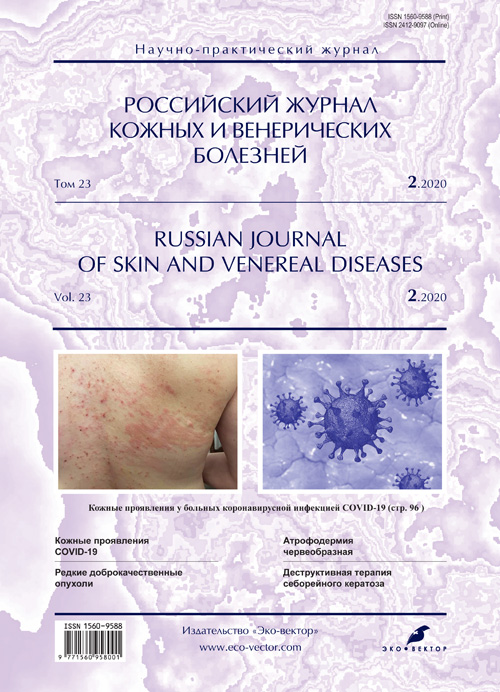Vol 23, No 2 (2020)
- Year: 2020
- Articles: 8
- URL: https://rjsvd.com/1560-9588/issue/view/2519
- DOI: https://doi.org/10.17816/dv.232
DERMATO-ONCOLOGY
Benign skin tumors arising from the adipose and muscle tissue
Abstract
Benign skin tumors arising from the adipose tissue (Derkum’s disease, Madelung’s disease, symmetrical lipomatosis) and the muscle tissue (leiomyoma) are rarely seen at a dermatological appointment, which creates diagnostic difficulties for practicing dermatologists. To improve diagnostic performance, the authors provide brief clinical descriptions and original images of these tumors.
 68-73
68-73


Benign skin tumors arising from the hair follicles and sweat glands
Abstract
This article discusses benign skin tumors originating from hair follicles and sweat glands, which can complicate the diagnosis for the medical practitioners. Original photos are used to illustrate the distinct clinical manifestations of these dermatoses.
 74-79
74-79


Seborrheic keratosis: external therapy with destractive solution
Abstract
This article describes the clinical aspects and treatment of seborrheic keratosis. The authors report the highly effective use of destructive therapy, 1.5% zinc chloropropionate solution in 2-chloropropionic acid, in patients with seborrheic keratosis.
 80-84
80-84


CLINICAL PICTURE, DIAGNOSIS, AND THERAPY OF DERMATOSES
Cutaneous manifestations of new coronavirus infection (COVID-19)
Abstract
This article presents the recently published data on the pathogenesis and cutaneous manifestations of the new coronavirus infection (COVID-19). The main symptoms of COVID-19 have already been well studied. However, recently, some reports on cutaneous manifestations (urticaria, papulae and vesicles, erythematous rash, purpura, livedo-angiitis, eruptive angioma, chilblain-like rash, pityriasis rosea, erythema multiforme, and periorbital dyschromia) in patients with COVID-19 have been made. Moreover, the healthcare professionals using personal protective equipment more frequently may develop occupational dermatoses.
 85-95
85-95


Skin manifestations in patients with a new coronavirus infection: clinical cases
Abstract
Clinical cases of cutaneous eruptions in patients with new coronavirus infection (COVID-19) are described. The authors conclude that predominant morphological eruptions in the form of macules, papules and weals are associated with COVID-19. As a rule, eruptions occur simultaneously with the onset of the first signs of the disease or several days later both in adult and children. The severity of COVID-19 does not generally correlate with the severity of skin clinical manifestations. The skin eruptions are most frequently difficult to attribute to a particular diagnosis, and they are often diagnosed as some kind of dermatosis. Skin eruptions regress quite shortly due to COVID-19 treatment and improvements in the patients’ general condition as well as the use of topical steroids, or even without treatment.
 96-108
96-108


Urticaria-like rash in a patient with COVID-19 associated pneumonia of moderate severity: aspects of pathogenesis
Abstract
In mid 2020, the number of new coronavirus (COVID-19) cases has exceeded globally six million. The clinical manifestations of COVID-19 infection are numerous mostly causing damage to the bronchopulmonary system in the form of a dry cough, rhinitis, dyspnea, fever, myalgia, and general weakness. Skin manifestations of COVID-19 are rare and currently include five types of skin lesions occurring during the infection process, which are reliably recorded in only a limited number of case reports and certain analytical publications. This article describes the clinical case of a 28-year-old patient with urticaria-like disseminated rash and confirmed COVID-19-associated pneumonia.
 109-114
109-114


Atrophoderma vermiculatum: clinical presentation features, differential diagnosis and treatment
Abstract
Atrophoderma vermiculata is a rare, benign, follicular dermatosis localized in an esthetically important facial skin zone, which results in superficial scars formation. The disease usually occurs at the age of 5–12 years and may be autosomal-dominantly inherited. This type of dermatosis may be associated with other congenital abnormalities and some hereditary diseases, such as Marfan syndrome, neurofibromatosis, congenital heart defects, and mental retardation similar to Down’s syndrome. The authors also analyze the typical clinical presentations of atrophoderma vermiculata, from their own clinical experience, conduct a detailed analysis of differential diagnosis with other dermatoses, and provide contemporary therapeutic methods and approaches to this skin disorder.
 115-118
115-118


COSMETOLOGY
Aspects of comprehensive treatment for adolescents with acne vulgaris from the perspective of psychological counseling
Abstract
This article discusses the manifestations of the adolescence crisis in patients with acne vulgaris, using a four-level personality model (biological, psychological, social, and spiritual levels). On the one hand, the adolescence crisis can trigger acne vulgaris in case of a genetic predisposition; on the other hand, acne can aggravate the process of experiencing the adolescence crisis. The authors suggest the use of psychological counseling (relaxation techniques, methods of rational psychotherapy, etc.) within the dermatological care for adolescent patients with mild and moderate acne vulgaris. The authors present the results of a study of the efficacy of comprehensive therapy (including psychological counseling) in adolescent patients with mild-to-moderate acne vulgaris, compared with traditional dermatotropic therapy. Statistically significant differences between two groups were revealed in the changes in the indicators of the mental condition presentation (r = -0.90; p < 0.05), the dermatological index of acne (DIA) (r = -0.34; p < 0.05), and indicators of quality of life (r = -0.72 and r = -0.68. according to the questionnaires of the Dermatology Life Quality Index and Skindex-29, resp.; p < 0.05). Simultaneous improvement in the psychoemotional status was correlated with positive cutaneous changes, as evidenced by the direct rather than pronounced statistically significant relationship between the indices of the experience scale and the ADI index (r = 0.52; p < 0.05). The obtained results show that the use of psychological counseling in the comprehensive treatment for adolescents with mild-to-moderate acne vulgaris is more effective compared with the traditional dermatotropic therapy.
 119-128
119-128












